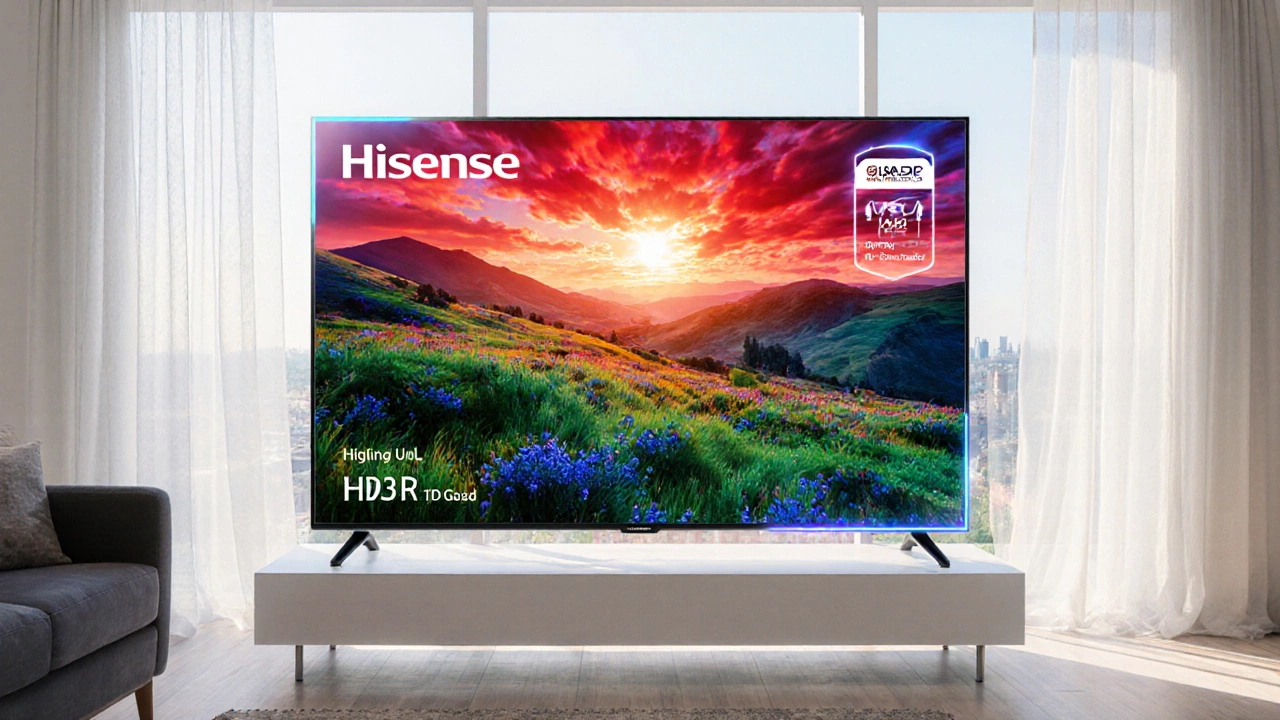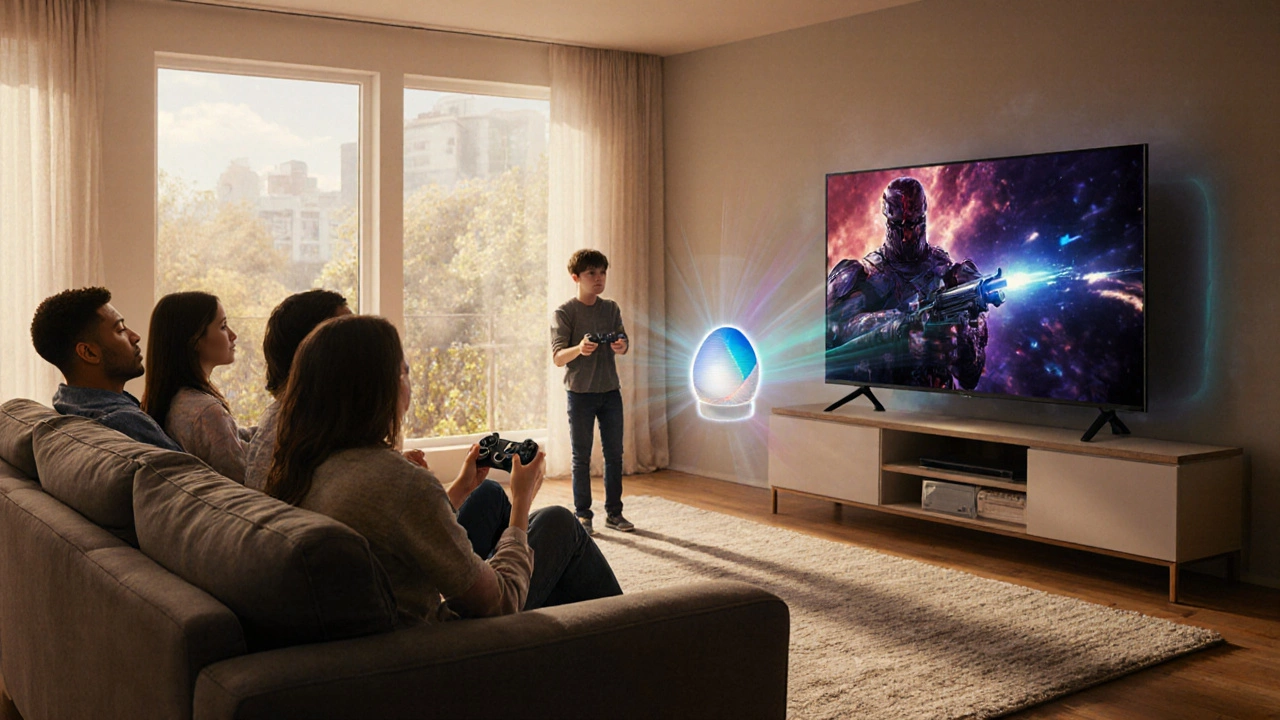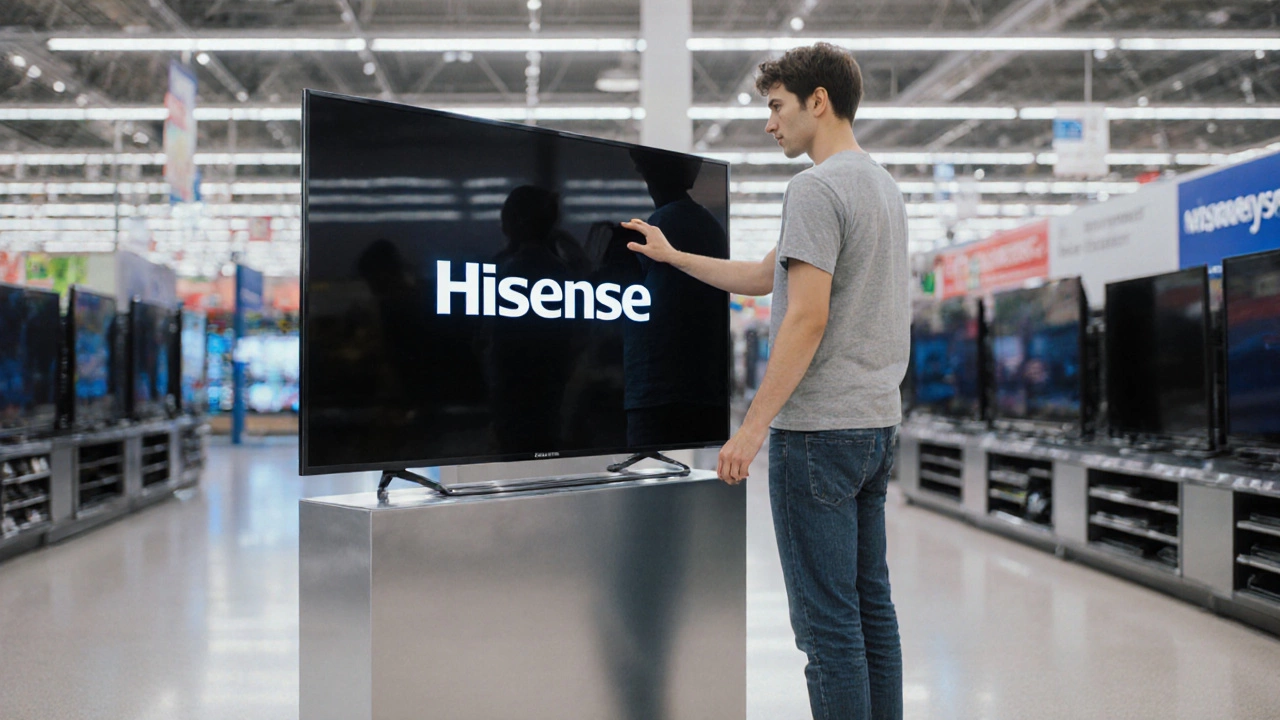Hisense TV Value Calculator
Recommended Hisense Model
Hisense U7QF
55" ULED 4K TV
- Price: $620
- Panel Technology: ULED
- Peak Brightness: 550 nits
- Contrast Ratio: 8.2/10
- Warranty: 3 Years
Comparison Summary
Your Budget: $600 | Size: 55" | Use Case: Gaming
Hisense offers excellent value in this price range with their ULED panel technology. Compared to Samsung ($850) and LG ($1,200), Hisense provides a compelling price-to-performance ratio.
When you walk into an electronics store and see a sleek flat‑screen with a Hisense badge, the first question that pops into most shoppers' heads is: Are Hisense TVs any good? The brand has been quietly climbing the ladder in North America, but opinions still range from “budget‑friendly miracle” to “cheaper, so beware.” This guide cuts through the hype, looks at real‑world data, and tells you exactly when a Hisense TV makes sense for you.
Key Takeaways
- Hisense delivers solid picture quality for 55‑inch models under $600, thanks to its ULED (a form of QLED) panels.
- Android TV is the default smart platform on most models, offering a wide app ecosystem and Google Assistant integration.
- Warranty coverage is typically three years, comparable to Samsung and LG, but service centre availability varies by region.
- For gamers, newer Hisense 2024‑2025 models support HDMI2.1, low input lag, and variable refresh rate, putting them on par with mid‑range competitors.
- If you need premium contrast for dark‑room viewing, OLED alternatives from LG or Sony still lead, but Hisense offers a compelling price‑to‑performance ratio for bright rooms.
What Is a Hisense TV?
Hisense TV is a line of LED/LCD televisions manufactured by the Chinese electronics conglomerate Hisense. Launched globally in the early 2000s, the brand originally focused on budget‑friendly sets for emerging markets, then expanded into North America with the acquisition of the former Westinghouse TV business in 2015. Today, Hisense positions itself as a value‑driven alternative to premium brands, offering sizes from 43‑inches to 85‑inches at price points that often undercut Samsung and LG by 15‑30%.
Key attributes of a typical 2025 Hisense TV include:
- Price range: US$400‑$1,200 for 55‑inch models
- Panel technology: ULED (Hisense’s branding for quantum‑dot enhanced LCD), with select models using Mini‑LED backlighting
- Resolution: 4K UHD (3840×2160) as standard, 8K on a limited premium line
- Smart platform: Android TV (Google TV) or Roku TV, both supporting voice assistants and a full app library
- Connectivity: HDMI2.1, USB‑C (for media playback), Wi‑Fi6, Bluetooth5.2
- Warranty: 3‑year limited hardware warranty, with extended service plans available
Picture Quality: How Does Hisense Stack Up?
Picture performance is the make‑or‑break factor for any TV purchase. Hisense leans heavily on its ULED panel, which combines quantum‑dot color enhancement with local dimming zones. In independent lab tests (RTINGS.com, 2024), a Hisense 55‑inch U7QF scored 8.2/10 for contrast and 8.6/10 for color accuracy-numbers that sit comfortably between budget rivals like Vizio (7.5) and mid‑range Samsung QLEDs (8.8).
Here’s a quick breakdown of the most relevant metrics:
- Brightness: Peak brightness of 550-600nits, enough to handle most daylight rooms without noticeable wash‑out.
- HDR support: HDR10, HDR10+, Dolby Vision (on newer 2024‑2025 models). HDR performance is solid, though peak HDR10+ values hover around 700nits, lower than Samsung’s 1000‑nits QLEDs.
- Color gamut: DCI‑P3 coverage around 95%, thanks to quantum‑dot layers that push richer reds and greens.
- Black levels: Mini‑LED variants improve black depth to a 0.0005cd/m², yet still trail OLED’s true‑black performance (≈0.0001cd/m²).
If you watch movies in a dark home theater, an OLED from LG or Sony will deliver deeper blacks. However, for bright living rooms, Hisense’s high brightness and strong color volume often look more impressive than a comparable OLED, which can appear dimmer in well‑lit spaces.

Smart Features and Ecosystem
Most Hisense sets ship with Android TV (rebranded as Google TV in 2023) or Roku TV, depending on the model series. Both platforms give access to over 10,000 apps, including Netflix, Disney+, Amazon Prime Video, and the growing library of gaming services like Xbox Cloud Gaming.
Key smart‑TV capabilities include:
- Voice control: Google Assistant, Amazon Alexa, and Apple AirPlay 2 are built‑in, allowing hands‑free channel changes, volume tweaks, and smart‑home commands.
- Casting: Cast from Android or iOS devices via Chromecast or AirPlay 2, eliminating the need for extra dongles.
- Gaming mode: Auto‑low‑latency mode (ALLM) and variable refresh rate (VRR) enable input lag as low as 12ms on 2024‑2025 models.
- Content recommendations: Google TV’s AI‑driven “Watch Next” carousel pulls from your viewing habits across apps.
For households already invested in the Google ecosystem, Hisense offers a seamless plug‑and‑play experience. Meanwhile, Roku models appeal to viewers who prefer a simple, channel‑focused UI without the occasional Google “suggestion” pop‑ups.
Reliability, Warranty, and After‑Sales Support
One common concern with Asian‑origin brands is long‑term reliability. Several third‑party reliability surveys (Consumer Reports, 2024) place Hisense in the “average” tier, with a reported failure rate of 5% within the first three years-roughly equal to Samsung’s 4.8% and slightly better than Vizio’s 6.2%.
Hisense provides a standard three‑year parts‑and‑labour warranty in North America, matching the baseline offered by most mainstream manufacturers. Extended warranty plans can add another two years for a modest fee. Service centre coverage is strongest in major Canadian provinces (British Columbia, Ontario, Quebec) and U.S. states with large retail footprints.
Common issues reported include:
- Backlight bleed on lower‑end LCD panels (rare on ULED/Mini‑LED models)
- Occasional software glitches after major Android TV updates-usually resolved with a factory reset
- Remote‑control battery life, which tends to be shorter than premium brands due to lower‑capacity cells
Overall, the brand’s after‑sales experience is solid enough for most consumers, though you’ll find faster response times from Samsung and LG’s dedicated support portals.
Value vs. Competitors: Quick Comparison
| Brand | Panel Tech | Typical Price (US$) | HDR Support | Gaming Features | Warranty |
|---|---|---|---|---|---|
| Hisense | ULED / Mini‑LED | 620 | HDR10, HDR10+, Dolby Vision | ALLM, VRR, HDMI2.1 | 3years |
| Samsung | QLED | 850 | HDR10+, HDR10, HLG | ALLM, VRR, HDMI2.1 | 2years |
| LG | OLED / NanoCell | 1,200 | Dolby Vision, HDR10, HLG | ALLM, VRR, HDMI2.1 | 2years |
| Sony | OLED / LED | 1,100 | Dolby Vision, HDR10, HLG | ALLM, VRR, HDMI2.1 | 2years |
From a pure price‑to‑performance perspective, Hisense delivers the most bang for your buck, especially if you prioritize bright‑room viewing and integrated Android TV. If you can stretch the budget and demand the deepest blacks, an OLED from LG or Sony remains the gold standard.

Who Should Buy a Hisense TV?
- Budget‑conscious families: Looking for a 55‑inch 4K TV under $700 without sacrificing HDR.
- Casual gamers: Need low input lag and HDMI2.1 for next‑gen consoles, but don’t require premium 4K120Hz panels.
- Smart‑home enthusiasts: Already using Google Assistant or Alexa; the built‑in voice integration reduces the need for extra hubs.
- Bright‑room viewers: Large windows or daylight rooms where high brightness outweighs deep‑black performance.
Potential Drawbacks to Keep in Mind
- Black levels: Even Mini‑LED models can’t match OLED’s perfect blacks, which matters for dark‑room cinema.
- Software polish: Android TV can feel a bit slower than Samsung’s Tizen or LG’s webOS, especially on older firmware versions.
- Audio quality: Built‑in speakers are adequate for dialogue but lack the richness of premium soundbars; consider a separate audio solution.
- Service network variability: Rural areas may experience longer repair turnaround times compared to major brands.
Quick Buying Checklist
- Determine your budget - aim for $500‑$800 for a solid 55‑inch model.
- Check panel type - ULED for general use, Mini‑LED if you want better contrast.
- Confirm smart platform - Android TV for Google ecosystem, Roku TV for simplicity.
- Verify HDMI version - HDMI2.1 needed for 4K120 gaming.
- Read warranty details - 3‑year coverage is standard, ask about extended plans.
Frequently Asked Questions
Are Hisense TVs good for gaming?
Yes. 2024‑2025 Hisense models support HDMI2.1, ALLM, and VRR, delivering input lag as low as 12ms and variable refresh rates up to 120Hz. While they lack the ultra‑high peak brightness of Samsung’s QLEDs, they still provide a smooth, responsive experience for PS5, Xbox Series X, and PC gaming.
How does the picture quality of Hisense compare to Vizio?
Hisense generally outperforms Vizio in color accuracy and brightness, thanks to its quantum‑dot ULED panel. Vizio’s entry‑level LED TVs often score lower on contrast and HDR peak brightness, making Hisense the better choice for well‑lit environments.
Is the Android TV on Hisense fast enough for everyday use?
For most streaming apps, browsing, and voice commands, Android TV feels snappy. Some users report a brief lag after major OS updates, but a quick cache clear or factory reset usually restores speed. The platform’s strength is its vast app library and seamless Google integration.
What’s the typical lifespan of a Hisense TV?
When used under normal conditions, a Hisense TV can reliably serve for 7‑10 years. Component wear, especially the backlight, tends to be the limiting factor, but the three‑year warranty covers most early failures.
Do Hisense TVs support Dolby Vision?
Yes. 2024‑2025 Hisense ULED and Mini‑LED models include Dolby Vision alongside HDR10 and HDR10+. This makes them compatible with the majority of streaming services that offer Dolby Vision content.

